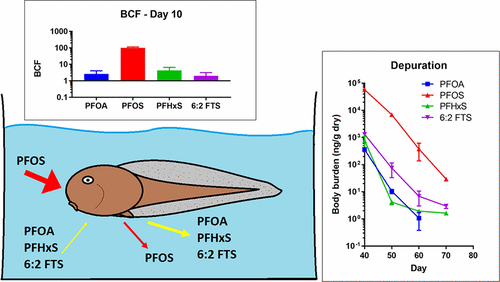当前位置:
X-MOL 学术
›
Environ. Sci. Technol. Lett.
›
论文详情
Our official English website, www.x-mol.net, welcomes your feedback! (Note: you will need to create a separate account there.)
Uptake and Depuration of Four Per/Polyfluoroalkyl Substances (PFASS) in Northern Leopard Frog Rana pipiens Tadpoles
Environmental Science & Technology Letters ( IF 10.9 ) Pub Date : 2017-09-22 00:00:00 , DOI: 10.1021/acs.estlett.7b00339 Gary M. Hoover 1 , Michael F. Chislock 1 , Brian J. Tornabene 1 , Samuel C. Guffey 1 , Youn Jeong Choi 2 , Chloe De Perre 2 , Jason T. Hoverman 1 , Linda S. Lee 2 , Maria S. Sepúlveda 1
Environmental Science & Technology Letters ( IF 10.9 ) Pub Date : 2017-09-22 00:00:00 , DOI: 10.1021/acs.estlett.7b00339 Gary M. Hoover 1 , Michael F. Chislock 1 , Brian J. Tornabene 1 , Samuel C. Guffey 1 , Youn Jeong Choi 2 , Chloe De Perre 2 , Jason T. Hoverman 1 , Linda S. Lee 2 , Maria S. Sepúlveda 1
Affiliation

|
Per/polyfluoroalkyl substances (PFASs) are persistent organic contaminants that are ubiquitous in surface waters. To date, their effects on aquatic systems, especially amphibians, are poorly understood. We examined the uptake and depuration of perfluorooctanesulfonate (PFOS), perfluorohexanesulfonate (PFHxS), perfluorooctanoic acid (PFOA), and 6:2 fluorotelomer sulfonate (6:2 FTS) in northern leopard frog (Rana pipiens) tadpoles. Whole-body concentrations were examined every 10 d during constant aqueous exposure to targeted concentrations of 10, 100, and 1000 μg/L for 40 d and for 30 d during depuration. Effects of PFAS exposure on length and development were also examined. Rapid uptake led to steady state concentrations by 10 d for most exposures. PFOS accumulated to the highest levels with whole-body bioconcentration factor (BCF) values at 40 d ranging from 19.6 to 119.3. The remaining PFASs were not found to bioconcentrate (BCF < 1.0 at 40 d). Furthermore, some BCF values decreased during the exposure phase, suggesting dilution due to growth and/or changes in toxicokinetics over ontogeny. During depuration, half-lives ranged from 1.2 to 3.3 d for all compounds. All PFASs tended to induce developmental delays, though statistical significance was only seen for PFOS and PFHxS. These sublethal effects observed at environmentally relevant concentrations are concerning and merit further study.
中文翻译:

吸收和四元/多氟烷基物质的净化(PFASS)在豹蛙蛙蚊蝌蚪
过/多氟烷基物质(PFAS)是持久性有机污染物,在地表水中普遍存在。迄今为止,人们对它们对水生系统,特别是两栖动物的影响知之甚少。我们检查了北豹蛙(Rana pipiens)中全氟辛烷磺酸盐(PFOS),全氟己烷磺酸盐(PFHxS),全氟辛酸(PFOA)和6:2氟调聚物磺酸盐(6:2 FTS)的摄取和净化情况).。在恒定水暴露于目标浓度10、100和1000μg/ L的情况下,连续40 d和净化期间的30 d,每10 d检查一次全身浓度。还检查了PFAS暴露对长度和发育的影响。对于大多数暴露而言,快速摄取导致稳态浓度降低了10 d。全氟辛烷磺酸累积至最高水平,全身生物浓缩因子(BCF)值在40 d范围从19.6至119.3。其余的PFAS未发现生物富集(40天时BCF <1.0)。此外,在接触阶段某些BCF值降低,这表明稀释是由于生长和/或毒代动力学在个体发育过程中的变化所致。在净化过程中,所有化合物的半衰期为1.2到3.3 d。所有PFAS都倾向于诱发发育迟缓,尽管仅对PFOS和PFHxS具有统计学意义。在环境相关浓度下观察到的这些亚致死作用值得关注,值得进一步研究。
更新日期:2017-09-22
中文翻译:

吸收和四元/多氟烷基物质的净化(PFASS)在豹蛙蛙蚊蝌蚪
过/多氟烷基物质(PFAS)是持久性有机污染物,在地表水中普遍存在。迄今为止,人们对它们对水生系统,特别是两栖动物的影响知之甚少。我们检查了北豹蛙(Rana pipiens)中全氟辛烷磺酸盐(PFOS),全氟己烷磺酸盐(PFHxS),全氟辛酸(PFOA)和6:2氟调聚物磺酸盐(6:2 FTS)的摄取和净化情况).。在恒定水暴露于目标浓度10、100和1000μg/ L的情况下,连续40 d和净化期间的30 d,每10 d检查一次全身浓度。还检查了PFAS暴露对长度和发育的影响。对于大多数暴露而言,快速摄取导致稳态浓度降低了10 d。全氟辛烷磺酸累积至最高水平,全身生物浓缩因子(BCF)值在40 d范围从19.6至119.3。其余的PFAS未发现生物富集(40天时BCF <1.0)。此外,在接触阶段某些BCF值降低,这表明稀释是由于生长和/或毒代动力学在个体发育过程中的变化所致。在净化过程中,所有化合物的半衰期为1.2到3.3 d。所有PFAS都倾向于诱发发育迟缓,尽管仅对PFOS和PFHxS具有统计学意义。在环境相关浓度下观察到的这些亚致死作用值得关注,值得进一步研究。



























 京公网安备 11010802027423号
京公网安备 11010802027423号